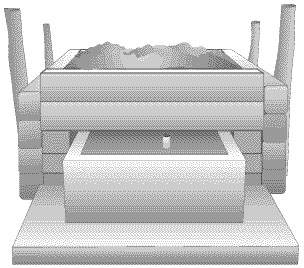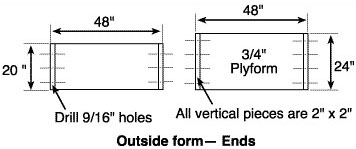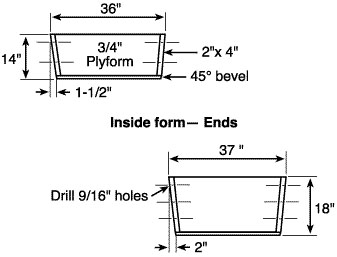
A constant supply of clean fresh water is essential to an efficient livestock operation. A system providing water that is neither too cold in winter nor too warm in summer will promote increased consumption and result in better animal performance.
The concrete tank described in this publication provides these benefits with a minimum of management, and because of its continuous trickle overflow, it requires no external power supply to prevent winter freezing (Figure 1). It also permits livestock to be fenced away from the pond water source, which eliminates losses through drowning and prolongs the life of the pond.
Concrete
The concrete mix used for the tank should be of high quality. If you purchase ready-mix, ask for a 3,000 psi mix containing 6 percent air entrainment. Air entrainment provides resistance to surface scaling and the deteriorating effects of acids.
If you plan to mix your own concrete, use clean gravel that contains no stones or aggregate materials larger than 1 inch in diameter. Buy a cement that has an air entraining additive in it and use six sacks of cement per cubic yard of concrete. Use just enough water to make the mix workable (not more than 6 gallons per sack of cement). A stiff mix makes for strong concrete.




- Remove all topsoil and organic material from the site where you plan to locate the tank. Organic matter left under the tank will decay and allow the tank to settle and crack.
- Install the water supply and overflow lines. The overflow should exit on the surface in a location where livestock will not use the water to make a mudhole. Place a screen over the overflow outlet to prevent rodents or small animals from entering the pipe. As an alternative, the pipe may be capped and several small holes drilled in the cap.
- Backfill and tamp ditches in which pipes run. Place 4 to 6 inches of gravel on the ground where the tank is to be located. The gravel reduces the danger of frost heaving the tank.
- Cut and shape the reinforcing bars for the tank using Figure 2 as a guide.
- Assemble the forms as shown in Figure 3. Apply a coating of grease to the inside form corner connections to permit easy removal of the forms. Use wing nuts on the corner bolts for the inside form. These wing nuts should be on the concrete side of the forms and will remain in the concrete after the forms are removed. Make sure these bolts are installed properly, or you will be unable to remove the forms without destroying them.
- Install supply and overflow pipes inside the tank. Plug the ends to keep out any spilled concrete.
- Check the reinforcing steel to be sure it is located at the center of the walls and floor.
- Assemble the cover slab forms on a flat surface and place the reinforcement in them. You can use a sheet of plastic under these forms to keep the concrete from sticking to the surface underneath.
- Spray or brush used motor oil on the inside of the forms to make removal easier.
- Pour the concrete into the forms, starting with the wall section. Work the concrete only enough to be sure there are no voids in it. The depression around the overflow pipe will have to be shaped by hand during the pouring operation (Figure 4).
- After two days (five is better), the forms can be removed. At this time, you can repair any surface imperfections with a concrete mortar mix.
- Install the shut-off valve and float valve, and trim the overflow pipe to the proper length.
- After the cover slabs have cured for at least seven days, they can be installed on the tank.
- A retaining wall bulkhead (Figure 1) can help prevent bank washout around the tank. Posts must be set 4 feet deep and holes filled with concrete.
- Form and pour a paved area around the tank to keep the area from becoming a mudhole. The step shown around the tank tends to reduce livestock fighting at the tank and prevents the deposit of manure in the tank. Some farmers also like to install a small corral and working chute at the tank site.
- Place fill around and over the back of the tank. Fill should be at least 2 feet deep to provide adequate frost protection (Figure 5). Seed the fill as soon as it is in place and fence livestock away from it.
Tank operation
The tank will require very little day-to-day attention. Periodic cleaning is required as feed and dirt tend to accumulate in it over time. The tank can be easily drained by shutting off the supply water and removing the overflow stand pipe. The float valve should be adjusted so that the normal water level is about 1/4 inch below the top of the overflow pipe.
Quarter-inch brass machine screws should be placed in the two drilled holes in the overflow pipe. In extremely cold weather, one or both of these can be removed to increase the overflow rate. This keeps the water temperature up and prevents freezing. During the hot summer months, the same procedure can be used to keep tank water cooler.
Reusable forms for tank
Use the plans shown in Figure 6 and the construction steps that follow to build a set of forms that may be reused many times. These steps should be followed in constructing forms.





- Assemble all required materials at the location of construction.
- Lay out and cut the pieces for the outside forms and the inside form ends. Use 8d galvanized nails to attach the 2 x 2 and 2 x 4 pieces to the plywood.
- Lay out and cut the inside form side pieces slightly over size. Fasten the 1 x 6 pieces to the sides and cut the assembled sides to the proper dimensions using bevel cuts as shown.
- Fasten the 2 x 4 pieces to the inside form side pieces.
- Cut three 2 x 4 pieces 4 feet 7 inches long to be used as form ties.
- Assemble the forms as shown using nails to hold the pieces in place temporarily.
- Drill 9/16-inch diameter holes in the locations shown. Forms can now be permanently assembled using 1/2-inch bolts.
- Cut 2 x 4 pieces for cover forms. These forms can be assembled using 16d nails.
- Seal the edges of the plywood (and the faces of plyform if not used) with a good-quality paint.